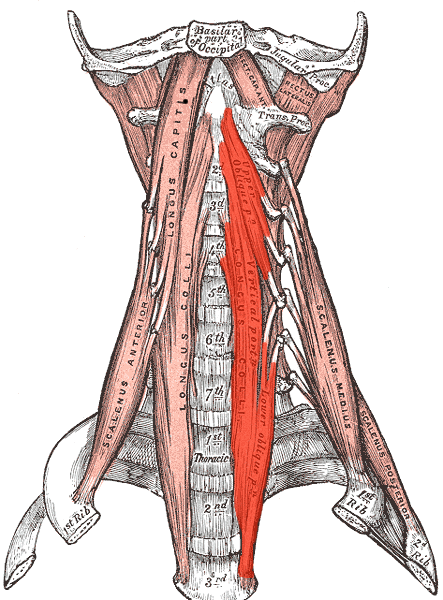Longus Colli: Difference between revisions
Venus Pagare (talk | contribs) No edit summary |
Venus Pagare (talk | contribs) No edit summary |
||
| Line 13: | Line 13: | ||
===== Vertical ===== | ===== Vertical ===== | ||
[[Image:Longus colli.png]] | [[Image:Longus colli.png]] | ||
== Etymology == | |||
The English name for this muscle is the long muscle of the neck. Longus is the Latin term for “long.”�The word colli comes from the Latin collum, which means the “neck.” <ref>http://www.anatomyexpert.com/structure_detail/5274/492/</ref> | |||
== Origin == | == Origin == | ||
| Line 47: | Line 51: | ||
== Blood Supply == | == Blood Supply == | ||
<span style="line-height: 1.5em;">The muscle receives blood from the ascending cervical artery, which is a small branch of the inferior thyroid artery from the thyrocervical trunk of the subclavian artery. It also receives blood from the ascending pharyngeal artery. <ref>http://www.anatomyexpert.com/structure_detail/5274/492/</ref></span> | |||
== Action == | == Action == | ||
| Line 55: | Line 59: | ||
== Function == | == Function == | ||
As well as acting with the other cervical flexors to produce neck flexion, Longus Colli has been shown to have a postural function on cervical curvature, counteracting the lordosis increment related to the weight of the head and to the contraction of the posterior cervical muscles<ref>Mayoux-Benhamou MA, Revel M, Vallée C, Roudier R, Barbet JP, Bargy F. Longus colli has a postural function on cervical curvature. Surg Radiol Anat. 1994;16(4):367-71</ref>. | As well as acting with the other cervical flexors to produce neck flexion, Longus Colli has been shown to have a postural function on cervical curvature, counteracting the lordosis increment related to the weight of the head and to the contraction of the posterior cervical muscles<ref>Mayoux-Benhamou MA, Revel M, Vallée C, Roudier R, Barbet JP, Bargy F. Longus colli has a postural function on cervical curvature. Surg Radiol Anat. 1994;16(4):367-71</ref>. | ||
It is commonly implicated in whiplash<ref>Jull, GA. Deep Cervical Flexor Muscle Dysfunction in Whiplash. 2000, Vol. 8, No. 1-2 , Pages 143-154</ref> | It is commonly implicated in whiplash<ref>Jull, GA. Deep Cervical Flexor Muscle Dysfunction in Whiplash. 2000, Vol. 8, No. 1-2 , Pages 143-154</ref> | ||
Impaired strength and endurance of the deep neck flexors has been found to be a feature of cervicogenic headache<ref>Zito G, Jull G, Story Clinical tests of musculoskeletal dysfunction in the diagnosis of cervicogenic headache IMan Ther. 2006 May; 11(2):118-29</ref>. | |||
<br> | |||
== Resources == | == Resources == | ||
Revision as of 20:24, 24 January 2014
Original Editor - Your name will be added here if you created the original content for this page.
Lead Editors - Venus Pagare, Admin, Wendy Walker, Tarina van der Stockt, WikiSysop, Kim Jackson and Manisha Shrestha
Description[edit | edit source]
Superior Oblique[edit | edit source]
Inferior Oblique[edit | edit source]
Vertical [edit | edit source]
Etymology[edit | edit source]
The English name for this muscle is the long muscle of the neck. Longus is the Latin term for “long.”�The word colli comes from the Latin collum, which means the “neck.” [1]
Origin[edit | edit source]
C3 to T3
Anterior tubercles and anterior surfaces of bodies of C3 to T3
Superior Oblique portion arises from anterior tubercles of the transverse processes of the third, fourth, and fifth cervical vertebræ
Inferior Oblique portion arises from the front of the bodies of the first two or three thoracic vertebræ
Vertical portion arises from the front of the bodies of the upper three thoracic and lower three cervical vertebræ
Insertion[edit | edit source]
Anterior arch of atlas, anterior tubercles of C5-6, anterior surfaces of bodies of vertebrae C2-4
Superior Oblique portion inserts into the tubercle on the anterior arch of the atlas
Inferior Oblique portion into the anterior tubercles of the transverse processes of the fifth and sixth cervical vertebræ
Verticle portion into the front of the bodies of the second, third, and fourth cervical vertebræ.
Nerve Supply[edit | edit source]
C2-6
Ventral rami
Blood Supply[edit | edit source]
The muscle receives blood from the ascending cervical artery, which is a small branch of the inferior thyroid artery from the thyrocervical trunk of the subclavian artery. It also receives blood from the ascending pharyngeal artery. [2]
Action[edit | edit source]
Cervical flexion, ipsilateral side flexion and some cervical rotation
Function[edit | edit source]
As well as acting with the other cervical flexors to produce neck flexion, Longus Colli has been shown to have a postural function on cervical curvature, counteracting the lordosis increment related to the weight of the head and to the contraction of the posterior cervical muscles[3].
It is commonly implicated in whiplash[4]
Impaired strength and endurance of the deep neck flexors has been found to be a feature of cervicogenic headache[5].
Resources[edit | edit source]
Recent Related Research (from Pubmed)[edit | edit source]
Extension:RSS -- Error: Not a valid URL: Feed goes here!!|charset=UTF-8|short|max=10
References[edit | edit source]
References will automatically be added here, see adding references tutorial.
- ↑ http://www.anatomyexpert.com/structure_detail/5274/492/
- ↑ http://www.anatomyexpert.com/structure_detail/5274/492/
- ↑ Mayoux-Benhamou MA, Revel M, Vallée C, Roudier R, Barbet JP, Bargy F. Longus colli has a postural function on cervical curvature. Surg Radiol Anat. 1994;16(4):367-71
- ↑ Jull, GA. Deep Cervical Flexor Muscle Dysfunction in Whiplash. 2000, Vol. 8, No. 1-2 , Pages 143-154
- ↑ Zito G, Jull G, Story Clinical tests of musculoskeletal dysfunction in the diagnosis of cervicogenic headache IMan Ther. 2006 May; 11(2):118-29







